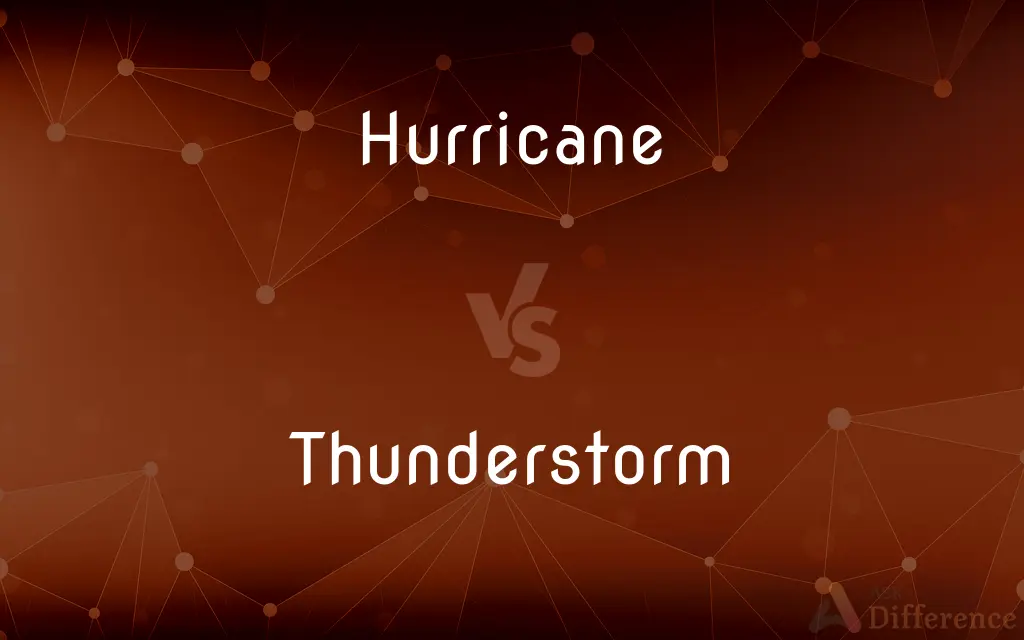Hurricane vs. Thunderstorm — What's the Difference?
By Tayyaba Rehman — Updated on November 5, 2023
A hurricane is a large, powerful storm with high winds over 74 mph, forming over warm ocean waters, while a thunderstorm is a smaller, localized storm with thunder, lightning, and rainfall.

Difference Between Hurricane and Thunderstorm
Table of Contents
ADVERTISEMENT
Key Differences
A hurricane is an intense tropical cyclone with sustained winds that exceed 74 miles per hour, characterized by a low-pressure center, spiral rainbands, and a high-speed circular wind pattern. Thunderstorms, by contrast, are storms accompanied by thunder and lightning and typically feature heavy rain or hail, but without the cyclonic structure and massive scale of hurricanes.
Hurricanes are classified by their wind speed on the Saffir-Simpson Hurricane Wind Scale, ranging from Category 1 to Category 5, with Category 5 being the most severe. Thunderstorms do not have such a scale and are generally not classified by their intensity in the same way, although they can be categorized by their potential to cause damage, like 'severe thunderstorms.'
The formation of a hurricane involves a complex interaction between the ocean and the atmosphere, requiring warm water, moist air, and converging equatorial winds. Thunderstorms, however, can form along weather fronts, over land or water, due to unstable air and a lifting mechanism like heat or mountains.
Hurricanes can cause widespread devastation, including storm surges, flooding, and catastrophic wind damage over large areas. Thunderstorms are more localized but can still be dangerous, leading to flash floods, lightning strikes, and occasionally spawning tornadoes.
While both hurricanes and thunderstorms can produce significant rainfall, the sheer size and organization of a hurricane often lead to prolonged periods of intense rain over broader areas, compared to the more isolated and shorter-duration downpours of a thunderstorm.
ADVERTISEMENT
Comparison Chart
Size
Large-scale system
Localized event
Winds
Over 74 mph, organized
Variable, can be gusty
Formation
Over warm ocean waters
Over land or water, various causes
Classification
Categories 1-5 based on wind speed
Not categorized by wind speed
Associated Hazards
Storm surges, widespread damage
Lightning, localized flooding
Compare with Definitions
Hurricane
Tropical cyclone
The hurricane uprooted trees as it swept through the town.
Thunderstorm
Heavy rain
The thunderstorm brought an hour of torrential rain.
Hurricane
High winds
Residents boarded up their homes in preparation for the hurricane.
Thunderstorm
Thunder and lightning
A loud clap of thunder announced the thunderstorm's arrival.
Hurricane
Low-pressure system
The barometric pressure dropped as the hurricane approached.
Thunderstorm
Potential hail
Hail from the thunderstorm dented cars and damaged roofs.
Hurricane
Eye
The eye of the hurricane passed directly over the island.
Thunderstorm
Atmospheric instability
The thunderstorm developed quickly due to the unstable air.
Hurricane
A severe tropical cyclone having winds greater than 64 knots (74 miles per hour; 119 kilometers per hour), originating in the equatorial regions of the Atlantic Ocean or Caribbean Sea or eastern regions of the Pacific Ocean, traveling north, northwest, or northeast from its point of origin, and usually involving heavy rains.
Thunderstorm
Localized storm
A single thunderstorm caused flash flooding in the area.
Hurricane
A wind with a speed greater than 64 knots (74 miles per hour; 119 kilometers per hour per hour), according to the Beaufort scale.
Thunderstorm
A thunderstorm, also known as an electrical storm or a lightning storm, is a storm characterized by the presence of lightning and its acoustic effect on the Earth's atmosphere, known as thunder. Relatively weak thunderstorms are sometimes called thundershowers.
Hurricane
Something resembling a hurricane in force or speed.
Thunderstorm
A storm with thunder and lightning and typically also heavy rain or hail.
Hurricane
A severe tropical cyclone in the North Atlantic Ocean, Caribbean Sea, Gulf of Mexico, or in the eastern North Pacific off the west coast of Mexico, with winds of 119 km/h (74 miles per hour) or greater accompanied by rain, lightning, and thunder that sometimes moves into temperate latitudes.
Thunderstorm
A transient, sometimes violent storm of thunder and lightning, often accompanied by rain and sometimes hail.
Hurricane
(meteorology) A wind scale for quite strong wind, stronger than a storm
Thunderstorm
A storm consisting of thunder and lightning produced by a cumulonimbus, usually accompanied with heavy rain, wind, and sometimes hail; and in rarer cases sleet, freezing rain, or snow.
Hurricane
"full—triple-full—full" – an acrobatic maneuver consisting of three flips and five twists, with one twist on the first flip, three twists on the second flip, one twist on the third flip
Thunderstorm
A storm accompanied with lightning and thunder.
Hurricane
A violent storm, characterized by extreme fury and sudden changes of the wind, and generally accompanied by rain, thunder, and lightning; - especially prevalent in the East and West Indies. Also used figuratively.
Like the smoke in a hurricane whirl'd.
Each guilty thought to me isA dreadful hurricane.
Thunderstorm
A storm resulting from strong rising air currents; heavy rain or hail along with thunder and lightning
Hurricane
A severe tropical cyclone usually with heavy rains and winds moving a 73-136 knots (12 on the Beaufort scale)
Hurricane
Rainbands
Satellite images showed the extensive rainbands of the hurricane.
Common Curiosities
Can a thunderstorm become a hurricane?
No, thunderstorms lack the structure and conditions needed to become hurricanes.
What defines a hurricane?
A hurricane is defined by sustained winds of at least 74 mph.
Do all thunderstorms produce tornadoes?
No, only some severe thunderstorms may produce tornadoes.
Are hurricanes always larger than thunderstorms?
Yes, hurricanes are large-scale systems, much bigger than thunderstorms.
How are thunderstorms detected?
Through radar and atmospheric observations.
What category of hurricane is the strongest?
Category 5 is the strongest on the Saffir-Simpson scale.
How long can a hurricane last?
A hurricane can last for more than a week.
Are hurricanes named?
Yes, hurricanes are named from predetermined lists.
Can hurricanes cause tornadoes?
Yes, hurricanes can spawn tornadoes when making landfall.
When is thunderstorm season?
It can vary but often peaks in the spring and summer.
What is the main danger of a thunderstorm?
The main dangers include lightning, heavy rain, and occasionally hail or tornadoes.
What sea temperatures favor hurricane development?
Sea surface temperatures above 80°F (27°C) are conducive.
How much rain can a thunderstorm produce?
It varies widely, but severe storms can produce several inches of rain.
Do thunderstorms occur at sea?
Yes, thunderstorms can occur over water.
Is there a “hurricane season”?
Yes, it typically runs from June to November in the Atlantic.
Share Your Discovery

Previous Comparison
Warfare vs. Battle
Next Comparison
Theory vs. OpinionAuthor Spotlight
Written by
Tayyaba RehmanTayyaba Rehman is a distinguished writer, currently serving as a primary contributor to askdifference.com. As a researcher in semantics and etymology, Tayyaba's passion for the complexity of languages and their distinctions has found a perfect home on the platform. Tayyaba delves into the intricacies of language, distinguishing between commonly confused words and phrases, thereby providing clarity for readers worldwide.













































